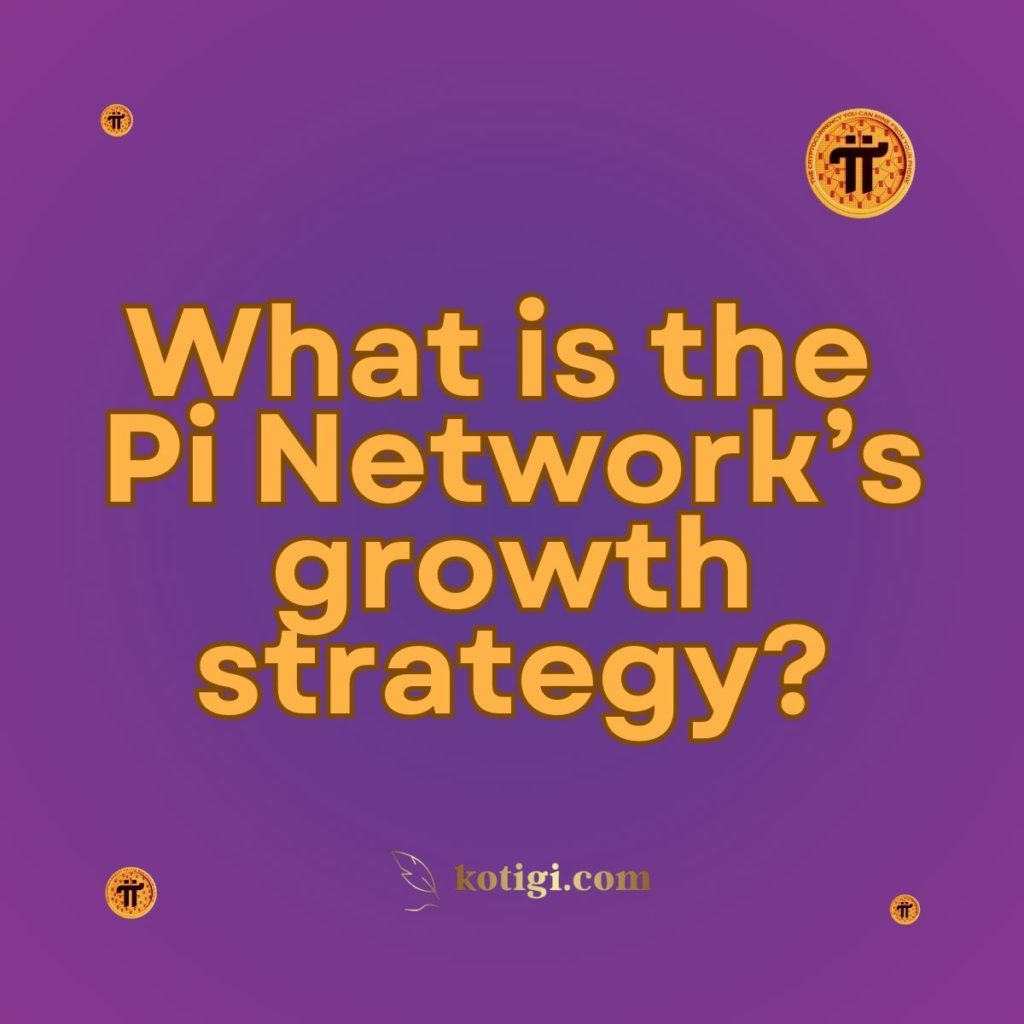
What is the Pi Network’s growth strategy?
Pi Network’s growth strategy focuses on achieving mass adoption by simplifying cryptocurrency mining through a mobile app, fostering community engagement, and developing a sustainable ecosystem. The platform aims to create real-world utility for its tokens while ensuring long-term growth through strategic partnerships, developer support, and a commitment to decentralization.
Introduction
Cryptocurrencies have long struggled with achieving mass adoption due to their technical complexities and high entry barriers. Launched in 2019 by a group of Stanford graduates, Pi Network addresses these challenges by allowing users to mine cryptocurrency directly through a mobile application, eliminating the need for expensive hardware and high energy consumption. This unique approach has led to rapid growth, attracting millions of users globally. Understanding Pi Network’s growth strategy is essential to grasp how the platform plans to maintain its momentum as it transitions to full decentralization and utility on its open mainnet.
Mobile-First Mining Strategy
Accessible Mining
Pi Network’s mobile-first mining strategy is crucial for its growth. Traditional cryptocurrencies like Bitcoin and Ethereum require specialized hardware and consume vast amounts of energy, posing significant barriers to entry for everyday users. In contrast, Pi Network enables users to mine Pi tokens using their smartphones, making cryptocurrency mining accessible to a global audience, including those in regions with limited technological infrastructure.
Gamification of Mining
To maintain user engagement, Pi Network incorporates gamification into its mining process. Users participate in daily mining sessions and can boost their mining rates through referrals. This gamified approach not only enhances user interaction but also promotes network growth, encouraging users to return daily to mine and invite others.
Security Circles
Security Circles enhance Pi Network’s security. Users can form groups with trusted members, thereby contributing to the network’s overall trust and security. This decentralized approach to building trust encourages users to invite more people to join, creating a more robust network.
Community-Centric Growth
Referral-Based Expansion
One of Pi Network’s most effective growth strategies is its referral-based model. When existing users invite others to join, both parties receive bonuses, such as increased mining rates. This creates a viral loop, motivating users to continuously recruit new participants, contributing to Pi Network’s exponential growth, which has seen over 45 million active pioneers by 2023.
Ambassador Program
The Ambassador Program empowers community members to help expand the network. Ambassadors receive rewards for their efforts to onboard new users. This incentive structure decentralizes growth, allowing users to actively participate in spreading the word about Pi Network, thus enhancing the community’s involvement.
Global Reach and Localization
Pi Network aims to reach users across different regions and demographics by supporting multiple languages and tailoring marketing campaigns. This effort broadens the platform’s appeal, ensuring that it resonates with users from highly developed regions to emerging markets where mobile technology is the primary access point for digital services.
Ecosystem Development
Building Utility for Pi Tokens
Creating real-world utility for Pi tokens is central to Pi Network’s growth strategy. Although Pi tokens currently hold no monetary value until the network’s open mainnet, Pi Network is laying the groundwork for an ecosystem where users can utilize these tokens in various transactions, enhancing the tokens’ attractiveness and usability.
Developer Engagement and dApps
The success of Pi Network hinges on the support of developers who will create decentralized applications (dApps) on its platform. To foster a vibrant developer community, Pi Network hosts hackathons and events that encourage innovation. By nurturing this ecosystem, Pi Network aims to provide real value to its users and sustain long-term engagement.
Pi Apps and Marketplace
The anticipated marketplace for Pi tokens is crucial for its ecosystem development. Users will be able to exchange goods and services using Pi tokens once the marketplace is fully operational. While still in testing, the success of this marketplace will significantly impact Pi Network’s long-term growth and user retention.
Strategic Partnerships
Collaboration with Businesses
Pi Network’s growth strategy involves forming partnerships with businesses willing to accept Pi tokens as payment. These partnerships facilitate real-world adoption and integration into existing markets. Pi Network has expressed its intent to collaborate with companies in various sectors, including retail, technology, and e-commerce, to enhance the value proposition for Pi token holders.
Building Infrastructure
The development team at Pi Network is actively working to establish a robust and scalable blockchain infrastructure capable of supporting a high volume of transactions. By prioritizing infrastructure development, Pi Network aims to sidestep some of the scalability challenges faced by other blockchain projects, positioning itself for future success.
Legal and Regulatory Compliance
To navigate the evolving landscape of cryptocurrency regulations, Pi Network is focused on ensuring compliance with various jurisdictions. This proactive approach minimizes the risk of legal hurdles that could impede growth, establishing Pi Network as a trustworthy and compliant platform in the eyes of regulators and users alike.
Pi Network’s Monetization Strategy
Low Transaction Fees
Pi Network plans to introduce transaction fees on its blockchain to create a monetization model. However, the platform aims to keep these fees low, encouraging users to engage frequently without facing financial barriers. This strategy will help sustain user participation and network activity.
Decentralized Applications (dApps) Revenue
Revenue generation from decentralized applications is another pillar of Pi Network’s monetization strategy. Developers of successful dApps will share a portion of their revenue with Pi Network, creating a win-win situation where both developers and the platform benefit. This model encourages innovation while ensuring that Pi Network has a consistent revenue stream.
Advertising and Data Monetization
With millions of active users, Pi Network could explore advertising and data monetization opportunities in the future. By introducing non-intrusive ads and monetizing user data responsibly, Pi Network can unlock additional revenue streams without compromising the user experience, contributing to its financial sustainability.
Pi Network’s Path to Decentralization
Staged Decentralization
Pi Network employs a staged approach to decentralization, having started as a centrally controlled project to ensure stability during its early stages. As the network progresses toward the open mainnet, control will gradually shift to the community. This method allows Pi Network to maintain security while increasing decentralization over time.
Community Governance
Community governance is integral to Pi Network’s decentralization strategy. Once the platform transitions to the open mainnet, users will play a significant role in decision-making regarding the network’s future. This governance model fosters a sense of ownership and trust among users, encouraging ongoing engagement.
Long-Term Growth and Sustainability
Scalability Solutions
Pi Network is investing in scalable solutions to support long-term growth. By building a blockchain capable of handling a high transaction volume, Pi Network aims to avoid the congestion issues faced by other platforms, ensuring seamless user experiences as the network grows.
Energy Efficiency
Pi Network’s energy-efficient consensus mechanism positions it as a more sustainable alternative to energy-intensive blockchains like Bitcoin. This commitment to sustainability resonates with environmentally conscious users, enhancing Pi Network’s appeal in an era increasingly focused on green technologies.
Ongoing Innovation
A commitment to ongoing innovation is crucial for Pi Network’s growth. The development team is dedicated to continually enhancing the platform and introducing new features that improve the user experience. This focus on innovation keeps Pi Network competitive in the rapidly evolving blockchain landscape.
Conclusion
Pi Network’s growth strategy encompasses a holistic approach emphasizing inclusivity, community engagement, and ecosystem development. By lowering the barriers to cryptocurrency mining through its mobile-first approach, Pi Network has successfully attracted a vast global user base. The platform’s dedication to building real-world utility for Pi tokens, coupled with strategic partnerships and robust developer support, positions it for sustained success. As Pi Network moves toward its open mainnet and decentralizes its governance, its growth strategy will continue to evolve, prioritizing scalability, sustainability, and ongoing innovation.
Key Takeaways
- Mobile-First Mining: Pi Network allows users to mine Pi tokens on their smartphones, making cryptocurrency accessible to a wider audience.
- Community Engagement: Pi Network’s referral system and ambassador program drive exponential user growth while fostering community involvement.
- Ecosystem Development: Plans for decentralized applications and a marketplace aim to create real-world utility for Pi tokens.
- Strategic Partnerships: Collaborations with businesses and investment in infrastructure are critical for long-term growth and adoption.
- Decentralization: A staged approach to decentralization ensures security while gradually transferring control to the community.





